index



Internal RV Ventilation
I have found a solution to having damp clothing; clothing that is not wet, like from rain,
but only slightly damp from a walk in the fog.
Years ago, I could have cold walls and condensation. I increased the insulation and this has helped.
Fans, as well as increased insulation, will help with condensation. Fans will not help in areas such as windows.
There, the weep holes must be checked and kept clear. Actually the fans will help with window condensation too:
The fans, although confined to isolated confined spaces, do promote more air circulation in the intire RV in general.
The fans will promote greater condensation on the windows, and thus the windows can drain more water to the outside.
There is plenty of solar available to gently and quitely run the fans and force air through closets.
As little as 5% solar flux will still run the fans; That is, with batteries charged and all other priorities met.
But the initial design was not to dry anything. The initial concept was heating the RV.
The first concept with air flow was to heat contents of cupboards, holds, and under the bed.
And to use the stored heat later at night.
Never the less, all three benefits, drying and thermal storage, fortuitously work together.
 Ventilation, drying of damp clothing.
Ventilation, drying of damp clothing.
 Dehumidifying from condensation on walls or cans.
Dehumidifying from condensation on walls or cans.
 Thermal inertia, heat storage
Thermal inertia, heat storage
I have internally ventilated five areas of the RV.

The Front Closet
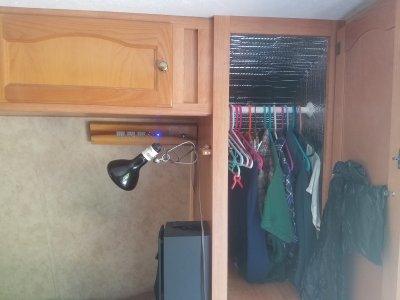 Here is one of the two clothes closets. This is a half height closets.
I am going to apply forced air ventilation, bottom to top.
Here is one of the two clothes closets. This is a half height closets.
I am going to apply forced air ventilation, bottom to top.
And as general interest:
The heat lamp is a very low wattage; I think 150 Watts.
It is totally infrared, and you can just barely see the "red" glow.
It applies plenty of heat directly to the bed.
I just wanted to explain anything in the picture...
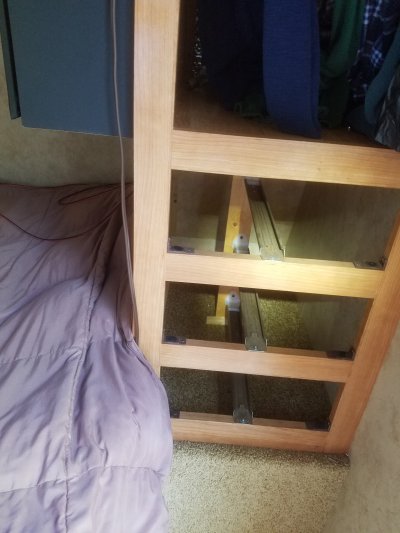 Each closet has drawers. It is not likely that underwear will become damp,
but the drawers are easy to ventilate, being directly in the air flow. So why not?
And any amount of mass will contribute to thermal inertia, even underwear.
Each closet has drawers. It is not likely that underwear will become damp,
but the drawers are easy to ventilate, being directly in the air flow. So why not?
And any amount of mass will contribute to thermal inertia, even underwear.
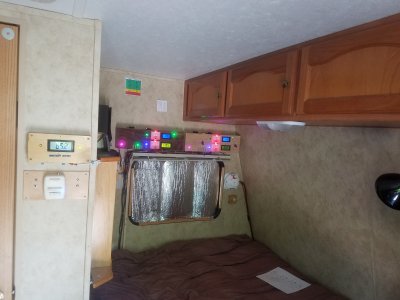 There is a top storage that can also be put "in-line" of the air flow. But flow can not be guaranteed.
The top storage spans the length to the other side, where it rests above my two Controllers.
There is a top storage that can also be put "in-line" of the air flow. But flow can not be guaranteed.
The top storage spans the length to the other side, where it rests above my two Controllers.
 The top storage is too problematic for air flow. It can be full with pillows and blankets.
High up places are great for storage of light and fluffy things.
Light things high, and heavy things low, keep the Trailer Center of Gravity low.
Also this space is used everyday.
So, the Top Storage overhead of the bed is out of consideration for forced air ventilation.
The top storage is too problematic for air flow. It can be full with pillows and blankets.
High up places are great for storage of light and fluffy things.
Light things high, and heavy things low, keep the Trailer Center of Gravity low.
Also this space is used everyday.
So, the Top Storage overhead of the bed is out of consideration for forced air ventilation.
 A small muffin fan is placed on the outside of the wall. It is not the best place.
The wall is hollow and is about one inch thick.
The fan could be placed inside the wall, or even inside the closet.
But installed here, the clothes have a greater chance of coming into
contact with the fan blades, or restricting flow. I have bought extra fan shields, but no, I will place outside.
A small muffin fan is placed on the outside of the wall. It is not the best place.
The wall is hollow and is about one inch thick.
The fan could be placed inside the wall, or even inside the closet.
But installed here, the clothes have a greater chance of coming into
contact with the fan blades, or restricting flow. I have bought extra fan shields, but no, I will place outside.
 Originally, all fan power was conceived as coming from a dedicated solar panel.
Originally, the fans would receive power from the 10 Watt solar panel.
The panel was a left over from a hot water project, and is now not used for anything.
The fan is a 24 volt fan pulling 75mA.
The fan is fed with about 20 volts that is further reduced with a 75 ohm resistor to reduce blower noise.
Originally, all fan power was conceived as coming from a dedicated solar panel.
Originally, the fans would receive power from the 10 Watt solar panel.
The panel was a left over from a hot water project, and is now not used for anything.
The fan is a 24 volt fan pulling 75mA.
The fan is fed with about 20 volts that is further reduced with a 75 ohm resistor to reduce blower noise.
But now, other sources of power are applied.
For example, a Schottky diode feeds Reject power to this circuit, as with so many other "opportunistic" feeders.
Actually, the closet fans are not opportunistic; They are on all the time if the sun is out.
It is just as with so many other devices, they have additional power available to them.
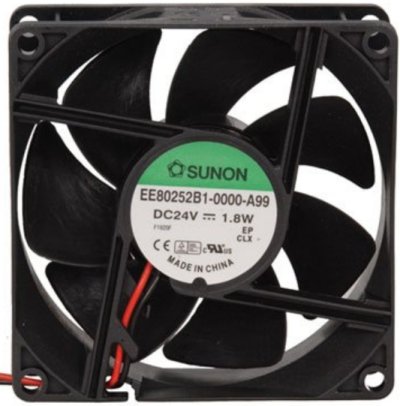 Of the five fans that I bought, this is by far the most expensive.
Of the five fans that I bought, this is by far the most expensive.
Price: $13.95 by Sunon
Size: 80mm
Ball bearing
Air Flow: 41 cfm
Noise: 33 dba
Current:at 24VDC 75 mA
By keeping the cfm down, you will be blessed with low noise, low current and longevity.
Beside the store-bought cfm, I placed an additional 75 ohm resister in series.
With 20 volts from the 10W panel feeding the resistor,
the fan voltage reads 16 volts for a 75mA fan, and 15 volts for a 100mA fan.
Both types of fans are whisper quiet and still push good air.
Sense these are brushless fans with active loading,
I added an electrolytic for stable power, useful for solid state electronics.
Without it, I can imagine loading of one fan interfering with other fans on the same line.
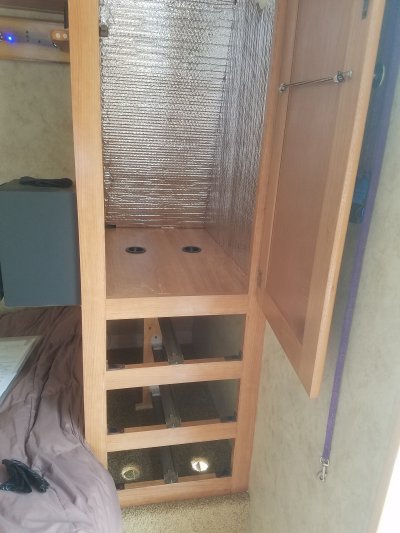 I put two 2 inch holes in the floor of the closet. I choose 2 inch because black collars are commonly available as used in electrical work.
The black grommets are for esthetics and dress up the holes.
I put two 2 inch holes in the floor of the closet. I choose 2 inch because black collars are commonly available as used in electrical work.
The black grommets are for esthetics and dress up the holes.
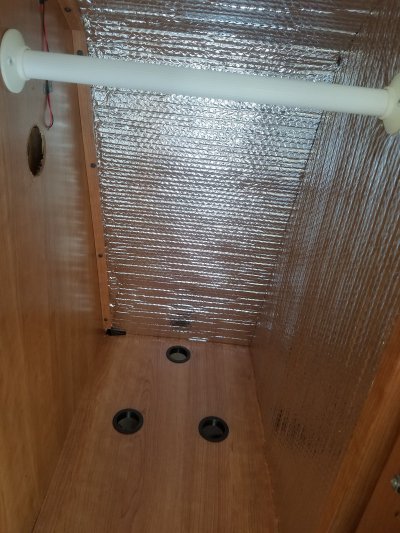 Made a mistake...
Made a mistake...
The two holes are directly under the clothes and are blocked most of the time. Some of my shirts drag the floor.
Can't erase the holes.
Made a third hole in the back, that is always clear.
This works much better, and I may have to make another hole in the front.
That is because the fan is an Eighty millimeter Fan, and has a diameter of 80mm.
It has a radius of 1.5 inches, and an area of 7 sq inches. My convenient 2 inch holes have an area of only 3.1 sq inches.
Therefore, it takes more than two of the 2 inch holes to equal one fan hole.
It just seems common sense to make the driven hole area the same as the passive hole areas.
 I may change the back hole to a three inch hole, and that means getting 3 inch grommets...
I may change the back hole to a three inch hole, and that means getting 3 inch grommets...
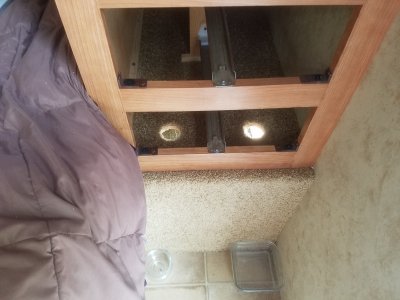 The two bottom holes go into a storage bay.
Bright sun light is coming through, as I have the storage bay door open on the outside.
The two bottom holes go into a storage bay.
Bright sun light is coming through, as I have the storage bay door open on the outside.

Front Storage is insulated with reflective styrofoam on the right external wall, and also the floor.
The wall to the left is an internal wall with no insulation.
|
My storage bays are insulated and also sealed. I consider them part of the living area.
The passage of air begins inside the RV in a storage bay (not shown),
and then enters this bay at the other end of the bay, (far end)
and comes through the bay toward the viewer, and comes up through these two holes,
and then up through the drawers and closet, drying any clothes in the process.
I thereby heat the contents of the bay and the closet during the warm day, and as a consequence,
store some latent heat.
In addition, I collect any moisture from the contents;
such as from lawn chairs, small inflatable boat, swim fins and stuff, spare parts and hoses;
all kinds of stuff that may have moisture.
Now, with my new system, if the wadded up inflatable boat is not completely dried before stowing, no problem.
There should be no mold or slime with this continuous ventilation.
Also, it is quick and easy: With this system, just throw the damp stuff in, and break camp in less than 60 seconds, and drive away.
I know of no other RVer with anything close to my system.
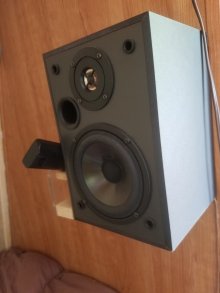 Got to mount the speaker someplace else. It is just hung on the wall of the closet and is in the way.
The same goes for the TV remote, which is kept on the left side of the speaker.
This venting project has many side projects that are distracting to the main goal. But they each have to be addressed.
Got to mount the speaker someplace else. It is just hung on the wall of the closet and is in the way.
The same goes for the TV remote, which is kept on the left side of the speaker.
This venting project has many side projects that are distracting to the main goal. But they each have to be addressed.
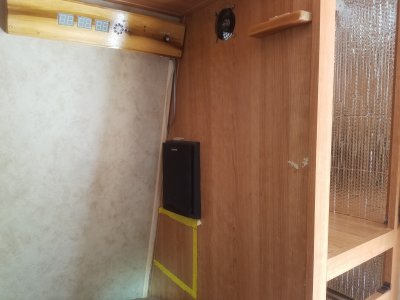 Making some changes to the Front Closet...
Making some changes to the Front Closet...
Found a spot for the speaker. Moving speaker to inside of closet with just the front of speaker sticking out and exposed.
Moved fan to inside of closet wall, which I should have done in the beginning.
Back side of fan is now exposed to clothes; so added a second grill cover.
The simulated cherry wood wallpaper is tearing off in places.
Cutting access door to secret storage area, outlined in yellow tape.
This is a large area of otherwise waisted space that is found behind the drawers.
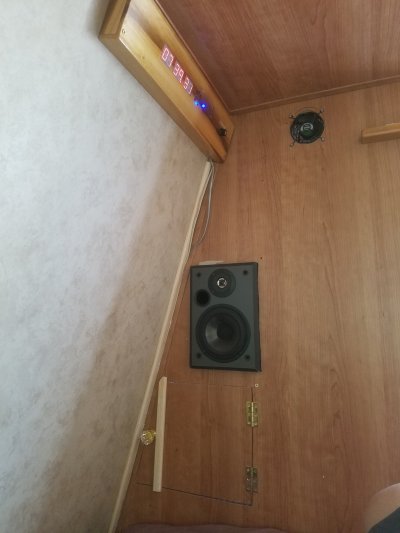 Moved fan inside the wall.
Moved fan inside the wall.
Installed speaker.
Added a pretty glass knob to open the door.
I guess the hidden area is no longer a secret, and is not so hidden.
There is plenty of area for night clothes and such.
There is a white mark above the speaker. As I pulled off the marking tape, the tape pulled off the cheap wallpaper.
A step forward, and a step backwards... RVs are built cheap.
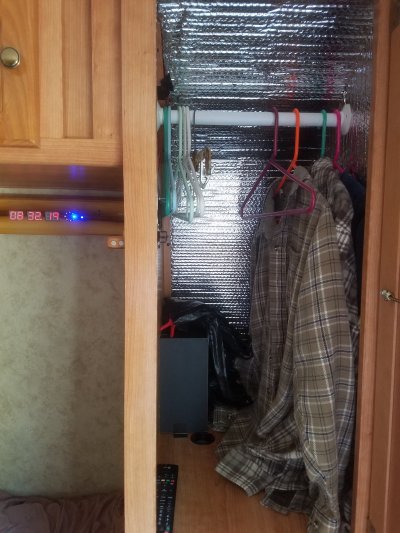 Had to move the hanging Bar up, and there is still a problem:
Long shirts still drag the bottom, and can cover the vent holes.
To have this venting thing work reliably, I may have to make some more vent holes in the floor of the closet.
Had to move the hanging Bar up, and there is still a problem:
Long shirts still drag the bottom, and can cover the vent holes.
To have this venting thing work reliably, I may have to make some more vent holes in the floor of the closet.

The Back Closet
 The Back Closet Fan can be placed in the floor of the closet, or at the top. It is all about the same difference.
However, if the closet door is left open, and the fan is placed at the top of the closet,
the inverter which is located under the closet will no longer get fresh air pulled across it.
So, I will mount on the closet floor.
The Back Closet Fan can be placed in the floor of the closet, or at the top. It is all about the same difference.
However, if the closet door is left open, and the fan is placed at the top of the closet,
the inverter which is located under the closet will no longer get fresh air pulled across it.
So, I will mount on the closet floor.
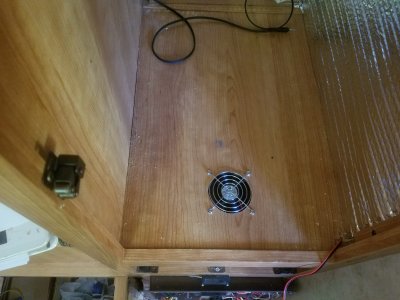 Decided to mount the fan in the bottom of the closet.
Decided to mount the fan in the bottom of the closet.
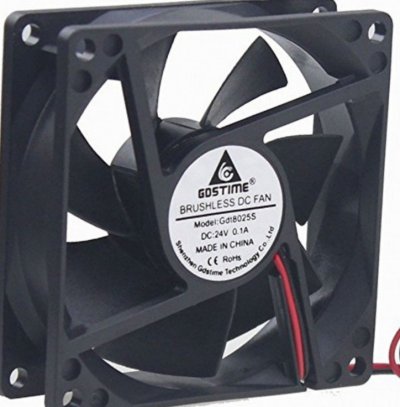 The Full Length closet has this fan...
The Full Length closet has this fan...
 Price: $8.99 by GosTime
Price: $8.99 by GosTime
Size: 80x80x25mm, 3.15x3.15x1 inches
Current: 24V 0.1Amp (Not very efficient, 25% more current with 7% more air)
Bearing type: Sleeve
Speed: 2800RPM
Air flow: 44CFM
Noise: 27dBA (very quiet, more quiet than Front closet bearing fan.)
With 7 blades
Life: 35,000 Hrs (16 years, full power, half days)
And Sleeves, for me, seem to be quieter than bearings.
Fan comes with a chrome screen grill, which is essential in a place that has clothes.
Separate grills had to be ordered for all other fans. Grills are important in clothes closets.
 After the air goes through the clothes, it exits at the top of the closet through the black hole.
After the air goes through the clothes, it exits at the top of the closet through the black hole.
What makes all this work so well, is that all compartments that are in the air path, are well sealed and insulated.
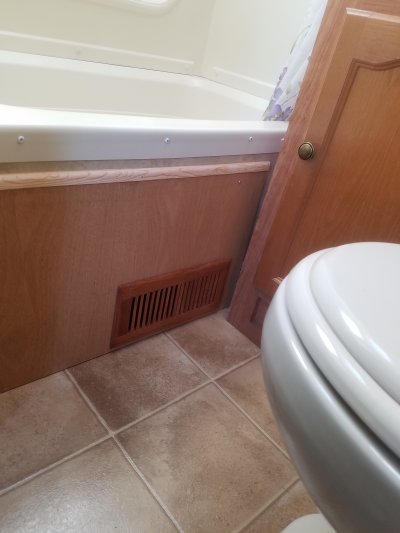
 Air starts out in the bathroom. Air inters and circulates under the bathtub.
Air inters through this oak grill which I had to install when I bought the trailer.
Evidently, RV manufactures encourage mold under bathtubs by not supplying a factory vent.
Air starts out in the bathroom. Air inters and circulates under the bathtub.
Air inters through this oak grill which I had to install when I bought the trailer.
Evidently, RV manufactures encourage mold under bathtubs by not supplying a factory vent.
Not much here that holds heat; as the tub is made of plastic.
However, a comment is due here to those that see humid air being pulled into potentially cold chambers.
If there is warm shower water, there is a warming of the tub. And that should mitigate condensation on the underside
of the tub. Always use the Vent Fan when taking a shower. Otherwise, you may see rust around the mirror, or worse yet - Mold!
Actually, worse yet, is mold that you do NOT see. But that is a whole different topic.
In short, my Vented System is better than ANY closed system.
 Water Pump Compartment as seen through the plexiglass door. The window/door is held in place by magnets.
Water Pump Compartment as seen through the plexiglass door. The window/door is held in place by magnets.
|
 From the tub compartment, the air moves left through a wall.
Next, the air inters the water pumping compartment.
The water pumping compartment lies under the refrigerator,
and includes three water pumps, a Water Filter, many hoses, and also the electrical cable used for Shore Power.
As far as latent heat, that copper cable is a gold mine.
From the tub compartment, the air moves left through a wall.
Next, the air inters the water pumping compartment.
The water pumping compartment lies under the refrigerator,
and includes three water pumps, a Water Filter, many hoses, and also the electrical cable used for Shore Power.
As far as latent heat, that copper cable is a gold mine.
If the temperature drops below 35F degrees, this area is heated with many small incandescent bulbs.
 The air next travels to a compartment that has the DC Utility Fuses, AC Breakers, Charger, and the Inverter.
This was originally another area that did not come vented from the factory.
Ventilation holes are now cut.
Part of this compartment sits on the steel WheelWell, originally a great source of heat loss.
Now, the area is insulated which is a requirement before Venting will work.
This area is more or less an "AC Power area". And it produces heat. It is a good thing it is now being vented.
The air is sucked in, on the right side through vent holes, and then vented in the up direction.
The air next travels to a compartment that has the DC Utility Fuses, AC Breakers, Charger, and the Inverter.
This was originally another area that did not come vented from the factory.
Ventilation holes are now cut.
Part of this compartment sits on the steel WheelWell, originally a great source of heat loss.
Now, the area is insulated which is a requirement before Venting will work.
This area is more or less an "AC Power area". And it produces heat. It is a good thing it is now being vented.
The air is sucked in, on the right side through vent holes, and then vented in the up direction.
 The next area is a closet drawer. Air circulates up and around the sides and also up and behind the drawer.
Plenty of clearance here with no air restriction.
The next area is a closet drawer. Air circulates up and around the sides and also up and behind the drawer.
Plenty of clearance here with no air restriction.
 The final area is the closet itself. This is where the fan is located.
Air comes up amongst the hanging clothes, and is vented at the top through the black grommet.
The final area is the closet itself. This is where the fan is located.
Air comes up amongst the hanging clothes, and is vented at the top through the black grommet.
As a side note: The speaker to the left is where all my devices talk. Devices in the RV talk to me.
The speaker also has sounds of the sun. I am still experimenting with this feature.

The Right Side Cabinets
 The air enters under the stove. This air also serves the combustion process in the stove.
With my modification to the oven, making it a sealed system with venting of gasses to the outside,
I am reluctant to run both internal circulation and external venting at the same time.
The air enters under the stove. This air also serves the combustion process in the stove.
With my modification to the oven, making it a sealed system with venting of gasses to the outside,
I am reluctant to run both internal circulation and external venting at the same time.
The stove area contains many canned goods.
The cans serve as a great heat sink, being steel and water, and both have a high Specific Heat.
A method to capitalize on specific heat was once told to me by my brother Bob,
and I believe he got the concept from our younger brother: brother Ben.
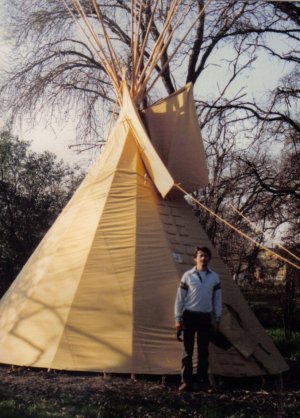 Strangely, Ben's first house. Ben and I were full brothers, and shared a love of building dwellings.
We had two different design approaches for Nature.
Strangely, Ben's first house. Ben and I were full brothers, and shared a love of building dwellings.
We had two different design approaches for Nature.
|
The family admired Ben because he knew everything about nature and the woods. He was an absolute genius!
Unlike the rest of us, Ben claimed he had Native American running in his blood,
and he gave this as the reason that knowing these things just came natural.
But unfortunately Ben was mistaken, DNA testing did not show it,
and his Indian status was officially relegated to only be in his heart.
But it did not change a thing with Ben; He was still "indian" and in love with the old ways.
Ben even traveled to Oregon to get the Lodge Pole Pine to build his TeePee. It had to be authentic!
Ben and I both build unorthodox things to live in. Ben stepped backward in time, and I stepped forward in time
to build our houses. We truly were, and are, brothers. Forever!
Getting back to the story...
My other brother,Bob, who was not indian, was sleeping in the cold woods with a good hot fire, which he could not keep going all night.
That was the problem: as soon as the fire went out, my brother Bob would freeze.
Actually, the problem was that he was not indian. Ben never had a "getting cold" problem.
Bob gathered large rocks and heated them for hours.
Bob placed the hot rocks under his suspended bed, insulated in pine needles. He said he was warm all night.
Bob and I both loved the knowledge of our younger brother Ben.
Although Ben was killed, he still rides with me to places of Nature in the RV.
We are brothers; One from the past, and one for the future. We are brothers in tune with Nature and physics.
 The next area is under the kitchen sink.
It is not a sealed compartment: Air is free to move between the stove and under the sink area.
So the two are really one as far as air flow is concerned.
It contains another water filter and several hoses, as well as three drawers of silverware and such.
It also contains more canned goods.
The next area is under the kitchen sink.
It is not a sealed compartment: Air is free to move between the stove and under the sink area.
So the two are really one as far as air flow is concerned.
It contains another water filter and several hoses, as well as three drawers of silverware and such.
It also contains more canned goods.
Talking about canned goods...
Condensation on canned goods produces rust spots.
With rust spots, the contents can not be trusted.
Ventilation here does not dry clothes, but it does dry and stop condensation.
And, of coarse, the intire RV still benefits from distribution of thermal mass.
I ran into this with my Slab House. The floor was entirely cement, and was a huge thermal reservor.
The temperature inside the house changes very little, and is easier to heat and cool.
But I am not laying down a slab of cement in my RV. Instead, I will rely on canned goods, steel, and water.

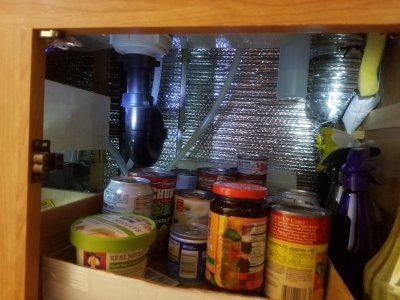 The next area, to the right contains one important thing: one of my accumulators. It is a large inverted bottle, and stores water pressure.
I know of no other RV accumulator like it:
You can see inside the glass accumulator, and read the pressure by the water level.
Unlike other RVs, my water pump is no longer an "On Demand" water pump.
The pump comes on once, pumps up to pressure, and then shuts off; Just like in a house.
I have maximum water pressure set for two atmospheres, about 30lbs. 50lbs is unsafe and will break factory RV hoses.
Cut-In pressure is set for one atmosphere, about 15 lbs.
The next area, to the right contains one important thing: one of my accumulators. It is a large inverted bottle, and stores water pressure.
I know of no other RV accumulator like it:
You can see inside the glass accumulator, and read the pressure by the water level.
Unlike other RVs, my water pump is no longer an "On Demand" water pump.
The pump comes on once, pumps up to pressure, and then shuts off; Just like in a house.
I have maximum water pressure set for two atmospheres, about 30lbs. 50lbs is unsafe and will break factory RV hoses.
Cut-In pressure is set for one atmosphere, about 15 lbs.

 The next area, to the right, is sort of an entertainment center. Not really; it contains only an FM/AM and CD deck,
and that does not qualify for an entertainment center, except in Keystones brochure.
In reality, it is empty storage. I never use the Genson.
I have no need for it in an RV:
There is nothing good on the FM or AM, and the CD only plays WAVs and can not play compressed formats.
RV manufacturers would be better off not including stupid stuff like this item,
because in an RV, unlike a house, everything has a place, and every place has something useful.
Also, the Tow Vehicle appreciates not hauling dead weight.
TVs and Radios are dead weight and are not very useful.
I will be throwing it away when I can think of something useful in its place.
The next area, to the right, is sort of an entertainment center. Not really; it contains only an FM/AM and CD deck,
and that does not qualify for an entertainment center, except in Keystones brochure.
In reality, it is empty storage. I never use the Genson.
I have no need for it in an RV:
There is nothing good on the FM or AM, and the CD only plays WAVs and can not play compressed formats.
RV manufacturers would be better off not including stupid stuff like this item,
because in an RV, unlike a house, everything has a place, and every place has something useful.
Also, the Tow Vehicle appreciates not hauling dead weight.
TVs and Radios are dead weight and are not very useful.
I will be throwing it away when I can think of something useful in its place.
 Although there is nothing in here, I still will be pulling air through this empty cabinet.
Although there is nothing in here, I still will be pulling air through this empty cabinet.
On a different subject...
You can see the Reflectix covering a long box like object.
That box like object is a steel fender well or wheel well.
Originally, all this object had for insulation was thin carpet: no padding, just cheap carpet.
Fender wells are made of steel, and must be insulated. Compared to the rest of
the wood flooring, steel is a fantastic conductor. Steel must be insulated!
RV manufacturers, in ignorance or blatant neglect, have made a huge mistake here when they failed to insulate.
I too made a mistake. I used reflectix, a poor thermal insulator. I later insulated with reflective sided styrofoam,
both a good thermal insulator and also a radiant reflector.

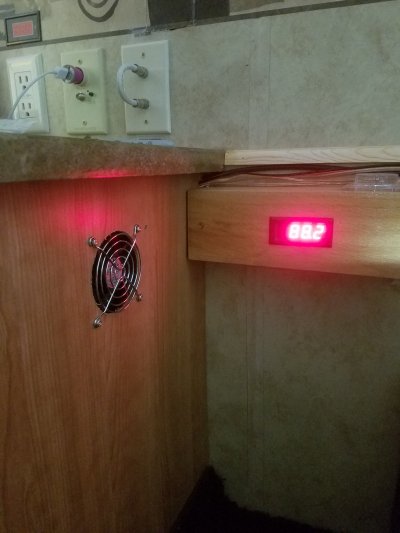 Fan works good. I choose the same fan as was in the Back closet.
Fan works good. I choose the same fan as was in the Back closet.
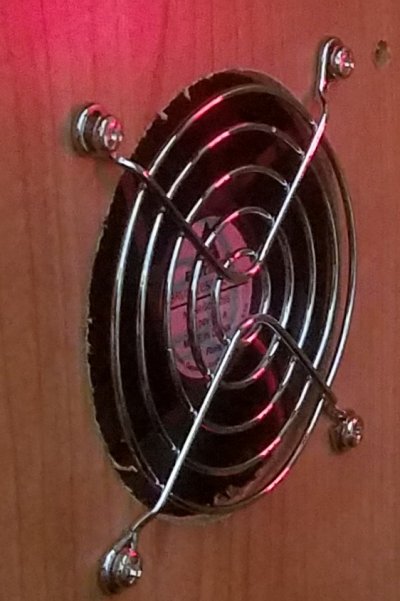 It comes with a chrome grill.
It comes with a chrome grill.
Price: $8.99 by GosTime
Size: 80x80x25mm, 3.15x3.15x1 inches
Current: 24V 0.1Amp
Bearing type: Sleeve
Speed: 2800RPM
Air flow: 44CFM
Noise: 27dBA
With 7 blades
It runs really quite.
I have more spare black grills for the back side, but it is not necessary at this time.

The Aft Storage Ventilation
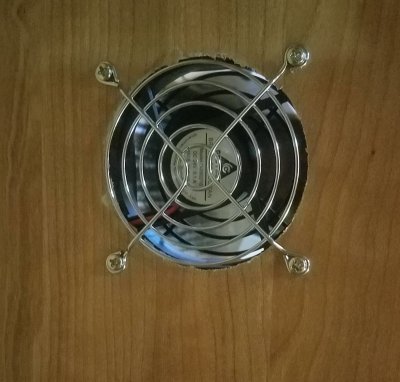 This fan is the same as the Back Storage and the Starboard Side :
This fan is the same as the Back Storage and the Starboard Side :
Price: $8.99 by GosTime
Size: 80x80x25mm, 3.15x3.15x1 inches
Current: 24V 0.1Amp
Bearing type: Sleeve
Speed: 2800RPM
Air flow: 44CFM
Noise: 27dBA
With 7 blades
I will have to see which type of fan is holding up the best in a few years;
bearing or sleeve, efficient or not, and which price.
Also, I will have to see how the brushless electronics hold up under varying supply voltages 0V to 20 Volts;
My RV has an unusual application.
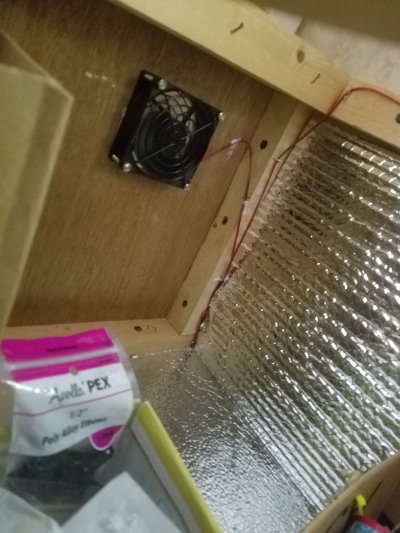 Good thing I bought extra grills, I installed an additional screen grill on the back of the fan.
The back of the fan is exposed to traffic, as things are taken in and out of this storage area all the time.
Good thing I bought extra grills, I installed an additional screen grill on the back of the fan.
The back of the fan is exposed to traffic, as things are taken in and out of this storage area all the time.

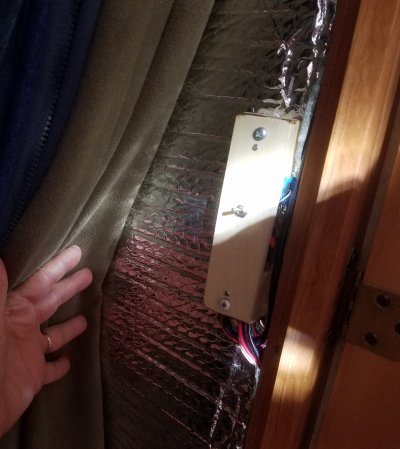 All fans are controlled from this one box, located in the back clothes closet.
It contains the supply diodes, equalizing resistors, and an electrolytic capacitor.
All fans are controlled from this one box, located in the back clothes closet.
It contains the supply diodes, equalizing resistors, and an electrolytic capacitor.
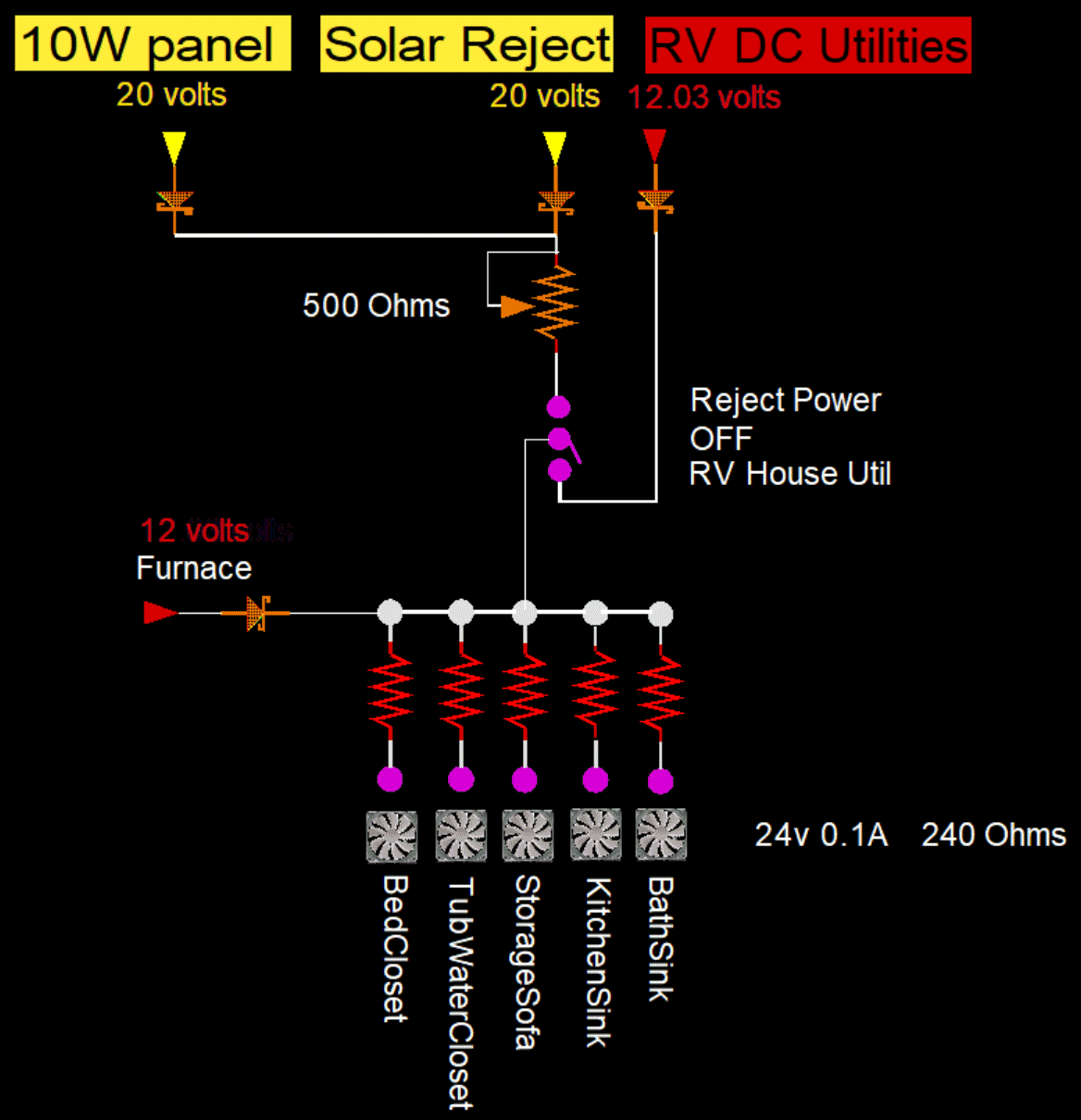 All of these 24 volt fans work from an independent 10 watt solar panel.
But if the 10 watt panel should fail, by being in the shade or something, the secondary system kicks in:
It is the Reject Power System, capable of very large amperages.
It has the same voltages as the 10 watt panel, which are from zero to 20 volts.
Whichever source has the higher voltage, will run the ventilation system.
However, the 10 watt panel should need no help: It can supply up to 500mA.
The fans generally pull half of 100mA each. Generally the 24v fans run on half voltages, or of about 12 volts.
These two sources of power use Schottky diodes to allow sharing.
All of these 24 volt fans work from an independent 10 watt solar panel.
But if the 10 watt panel should fail, by being in the shade or something, the secondary system kicks in:
It is the Reject Power System, capable of very large amperages.
It has the same voltages as the 10 watt panel, which are from zero to 20 volts.
Whichever source has the higher voltage, will run the ventilation system.
However, the 10 watt panel should need no help: It can supply up to 500mA.
The fans generally pull half of 100mA each. Generally the 24v fans run on half voltages, or of about 12 volts.
These two sources of power use Schottky diodes to allow sharing.
There are two other sources of power for the fans.
The first, comes from the Central Air Furnace. When the furnace is onn, then all these circulating fans, all over the RV, come onn.
Again, a Schottky must be employed to join the multiple power sources.
Most of these fans, blow cold air out into the room. And you can feel it! Which also means that they are sucking in warm air from the furnace.
When I first purchased the RV, I was planning to cut holes in the Central Air rectangular conduit. Then, attach air ducting flexible hose to all the cabinets and closets.
I could not get through or around the floor joists. This method with the fans accomplishes the same result with no construction effort.
And of course, the last method is with the manual switch that supplies the regulated Coach supply voltage to the fans. It is great for testing and such.
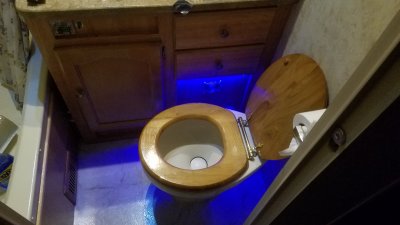 Here is the fan in the bathroom. Also installed a blue light strip to indicated when the fans are on.
Normally, you can not hear them.
On a cloudy day, brightness varies, as well as the fan speeds.
Here is the fan in the bathroom. Also installed a blue light strip to indicated when the fans are on.
Normally, you can not hear them.
On a cloudy day, brightness varies, as well as the fan speeds.

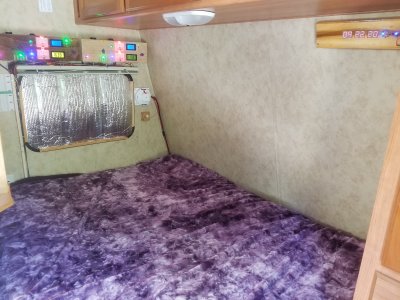 Reflective side in, heats inside.
Reflective side in, heats inside.
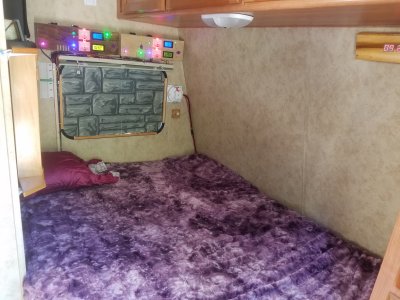 Reflective side out, keeps inside cool.
Reflective side out, keeps inside cool.

 Here is one of the two clothes closets. This is a half height closets.
I am going to apply forced air ventilation, bottom to top.
Here is one of the two clothes closets. This is a half height closets.
I am going to apply forced air ventilation, bottom to top.
 Each closet has drawers. It is not likely that underwear will become damp,
but the drawers are easy to ventilate, being directly in the air flow. So why not?
And any amount of mass will contribute to thermal inertia, even underwear.
Each closet has drawers. It is not likely that underwear will become damp,
but the drawers are easy to ventilate, being directly in the air flow. So why not?
And any amount of mass will contribute to thermal inertia, even underwear.
 There is a top storage that can also be put "in-line" of the air flow. But flow can not be guaranteed.
The top storage spans the length to the other side, where it rests above my two Controllers.
There is a top storage that can also be put "in-line" of the air flow. But flow can not be guaranteed.
The top storage spans the length to the other side, where it rests above my two Controllers.
 The top storage is too problematic for air flow. It can be full with pillows and blankets.
High up places are great for storage of light and fluffy things.
Light things high, and heavy things low, keep the Trailer Center of Gravity low.
Also this space is used everyday.
So, the Top Storage overhead of the bed is out of consideration for forced air ventilation.
The top storage is too problematic for air flow. It can be full with pillows and blankets.
High up places are great for storage of light and fluffy things.
Light things high, and heavy things low, keep the Trailer Center of Gravity low.
Also this space is used everyday.
So, the Top Storage overhead of the bed is out of consideration for forced air ventilation.
 A small muffin fan is placed on the outside of the wall. It is not the best place.
The wall is hollow and is about one inch thick.
The fan could be placed inside the wall, or even inside the closet.
But installed here, the clothes have a greater chance of coming into
contact with the fan blades, or restricting flow. I have bought extra fan shields, but no, I will place outside.
A small muffin fan is placed on the outside of the wall. It is not the best place.
The wall is hollow and is about one inch thick.
The fan could be placed inside the wall, or even inside the closet.
But installed here, the clothes have a greater chance of coming into
contact with the fan blades, or restricting flow. I have bought extra fan shields, but no, I will place outside.
 Originally, all fan power was conceived as coming from a dedicated solar panel.
Originally, the fans would receive power from the 10 Watt solar panel.
The panel was a left over from a hot water project, and is now not used for anything.
The fan is a 24 volt fan pulling 75mA.
The fan is fed with about 20 volts that is further reduced with a 75 ohm resistor to reduce blower noise.
Originally, all fan power was conceived as coming from a dedicated solar panel.
Originally, the fans would receive power from the 10 Watt solar panel.
The panel was a left over from a hot water project, and is now not used for anything.
The fan is a 24 volt fan pulling 75mA.
The fan is fed with about 20 volts that is further reduced with a 75 ohm resistor to reduce blower noise.
 Of the five fans that I bought, this is by far the most expensive.
Of the five fans that I bought, this is by far the most expensive. I put two 2 inch holes in the floor of the closet. I choose 2 inch because black collars are commonly available as used in electrical work.
The black grommets are for esthetics and dress up the holes.
I put two 2 inch holes in the floor of the closet. I choose 2 inch because black collars are commonly available as used in electrical work.
The black grommets are for esthetics and dress up the holes.
 Made a mistake...
Made a mistake...  I may change the back hole to a three inch hole, and that means getting 3 inch grommets...
I may change the back hole to a three inch hole, and that means getting 3 inch grommets...
 The two bottom holes go into a storage bay.
Bright sun light is coming through, as I have the storage bay door open on the outside.
The two bottom holes go into a storage bay.
Bright sun light is coming through, as I have the storage bay door open on the outside.

 Got to mount the speaker someplace else. It is just hung on the wall of the closet and is in the way.
The same goes for the TV remote, which is kept on the left side of the speaker.
This venting project has many side projects that are distracting to the main goal. But they each have to be addressed.
Got to mount the speaker someplace else. It is just hung on the wall of the closet and is in the way.
The same goes for the TV remote, which is kept on the left side of the speaker.
This venting project has many side projects that are distracting to the main goal. But they each have to be addressed.
 Making some changes to the Front Closet...
Making some changes to the Front Closet... Moved fan inside the wall.
Moved fan inside the wall. Had to move the hanging Bar up, and there is still a problem:
Long shirts still drag the bottom, and can cover the vent holes.
To have this venting thing work reliably, I may have to make some more vent holes in the floor of the closet.
Had to move the hanging Bar up, and there is still a problem:
Long shirts still drag the bottom, and can cover the vent holes.
To have this venting thing work reliably, I may have to make some more vent holes in the floor of the closet.
 The Back Closet Fan can be placed in the floor of the closet, or at the top. It is all about the same difference.
However, if the closet door is left open, and the fan is placed at the top of the closet,
the inverter which is located under the closet will no longer get fresh air pulled across it.
So, I will mount on the closet floor.
The Back Closet Fan can be placed in the floor of the closet, or at the top. It is all about the same difference.
However, if the closet door is left open, and the fan is placed at the top of the closet,
the inverter which is located under the closet will no longer get fresh air pulled across it.
So, I will mount on the closet floor.
 Decided to mount the fan in the bottom of the closet.
Decided to mount the fan in the bottom of the closet.
 The Full Length closet has this fan...
The Full Length closet has this fan... Price: $8.99 by GosTime
Price: $8.99 by GosTime 
 Water Pump Compartment as seen through the plexiglass door. The window/door is held in place by magnets.
Water Pump Compartment as seen through the plexiglass door. The window/door is held in place by magnets.
 Strangely, Ben's first house. Ben and I were full brothers, and shared a love of building dwellings.
We had two different design approaches for Nature.
Strangely, Ben's first house. Ben and I were full brothers, and shared a love of building dwellings.
We had two different design approaches for Nature.
 The next area, to the right contains one important thing: one of my accumulators. It is a large inverted bottle, and stores water pressure.
I know of no other RV accumulator like it:
You can see inside the glass accumulator, and read the pressure by the water level.
Unlike other RVs, my water pump is no longer an "On Demand" water pump.
The pump comes on once, pumps up to pressure, and then shuts off; Just like in a house.
I have maximum water pressure set for two atmospheres, about 30lbs. 50lbs is unsafe and will break factory RV hoses.
Cut-In pressure is set for one atmosphere, about 15 lbs.
The next area, to the right contains one important thing: one of my accumulators. It is a large inverted bottle, and stores water pressure.
I know of no other RV accumulator like it:
You can see inside the glass accumulator, and read the pressure by the water level.
Unlike other RVs, my water pump is no longer an "On Demand" water pump.
The pump comes on once, pumps up to pressure, and then shuts off; Just like in a house.
I have maximum water pressure set for two atmospheres, about 30lbs. 50lbs is unsafe and will break factory RV hoses.
Cut-In pressure is set for one atmosphere, about 15 lbs.

 Although there is nothing in here, I still will be pulling air through this empty cabinet.
Although there is nothing in here, I still will be pulling air through this empty cabinet.

 Fan works good. I choose the same fan as was in the Back closet.
Fan works good. I choose the same fan as was in the Back closet.
 It comes with a chrome grill.
It comes with a chrome grill.  This fan is the same as the Back Storage and the Starboard Side :
This fan is the same as the Back Storage and the Starboard Side : Good thing I bought extra grills, I installed an additional screen grill on the back of the fan.
The back of the fan is exposed to traffic, as things are taken in and out of this storage area all the time.
Good thing I bought extra grills, I installed an additional screen grill on the back of the fan.
The back of the fan is exposed to traffic, as things are taken in and out of this storage area all the time.
 All fans are controlled from this one box, located in the back clothes closet.
It contains the supply diodes, equalizing resistors, and an electrolytic capacitor.
All fans are controlled from this one box, located in the back clothes closet.
It contains the supply diodes, equalizing resistors, and an electrolytic capacitor.
 All of these 24 volt fans work from an independent 10 watt solar panel.
But if the 10 watt panel should fail, by being in the shade or something, the secondary system kicks in:
It is the Reject Power System, capable of very large amperages.
It has the same voltages as the 10 watt panel, which are from zero to 20 volts.
Whichever source has the higher voltage, will run the ventilation system.
However, the 10 watt panel should need no help: It can supply up to 500mA.
The fans generally pull half of 100mA each. Generally the 24v fans run on half voltages, or of about 12 volts.
These two sources of power use Schottky diodes to allow sharing.
All of these 24 volt fans work from an independent 10 watt solar panel.
But if the 10 watt panel should fail, by being in the shade or something, the secondary system kicks in:
It is the Reject Power System, capable of very large amperages.
It has the same voltages as the 10 watt panel, which are from zero to 20 volts.
Whichever source has the higher voltage, will run the ventilation system.
However, the 10 watt panel should need no help: It can supply up to 500mA.
The fans generally pull half of 100mA each. Generally the 24v fans run on half voltages, or of about 12 volts.
These two sources of power use Schottky diodes to allow sharing.
 Here is the fan in the bathroom. Also installed a blue light strip to indicated when the fans are on.
Normally, you can not hear them.
On a cloudy day, brightness varies, as well as the fan speeds.
Here is the fan in the bathroom. Also installed a blue light strip to indicated when the fans are on.
Normally, you can not hear them.
On a cloudy day, brightness varies, as well as the fan speeds.
 Reflective side in, heats inside.
Reflective side in, heats inside.
 Reflective side out, keeps inside cool.
Reflective side out, keeps inside cool.